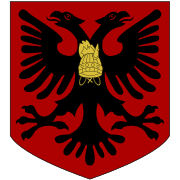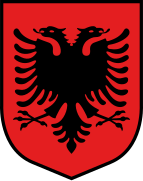Albanian coat of arms
The coat of arms of Albania is an adaptation of the state flag. It is based on the seal of Gjergj Kastriot Skanderbeg (1405-1468), a national hero during the fight against the Ottoman occupation. Precisely the emblem on the head of the double-headed eagle is Skanderbeg's helmet, with two goat's horns.
It is gules, with a double-headed eagle of sable. Finally, a representation of Skanderbeg's helmet in gold.
Described in the 1999 Constitution, it was officially adopted on July 31, 2002, replacing that of the former Socialist People's Republic of Albania, with the saber eagle surmounted by a five-pointed red star and surrounded of bundles of gold ears, tied with a gules ribbon with the inscription «24 Maj 1944» (in Spanish, May 24, 1944), date of the Përmet Congress, where Enver Hoxha was proclaimed prime minister of the Albanian provisional government during the Nazi occupation.
Historical evolution
Principality of Albania
The coat of arms of the Principality of Albania is described below: A black double-headed eagle with golden arms and red tongue with bundles of four golden rays on each fang, on the chest covered with a black-red embroidered shield bordered with gold, facing a natural colored peacock - showing his pride - all under an ermine-lined purple cloak with gold fringes, which falls from the Albanian princely crown. Blue banner with Wied's motto "FIDELITATE ET VERITATE" in gold letters ". Designed by Emil Doepler. Adopted on April 10, 1914. Its translation means Fidelity and Truth
Republic of Albania
The State Arms of the Albanian Republic are represented on a red rectangular flag, with a black double-headed eagle, with silver arms and banners centered on the eagle's chest. Adopted July 12, 1926.
Kingdom of Albania
The heraldic emblem of the Albanian monarchy is a double-headed eagle set on a shield surrounded by a gold-edged papal red silk cloak with shoulders, with Skanderbeg's helmet on top facing to the right when one looks at it. Black spots on a white background surround the two-headed eagle, which is placed on a red shield in the center, representing the Albanian national flag. A color illustration of the emblem can be found on the cover of the book 10 Vjet Mbretni by Zoi Xoxa. (Heraldic description: Gules, a double-headed sable eagle; on a cloak of gules, ropes, and double ermine tassels or; all ensign with a Skanderbeg cap, on a sinister goat's head proper.) First adopted 8 August 1929.
Italian Albania
The Great Arms of the State consist of a red shield with a black double-headed eagle crowned with Skanderbeg's Helmet. Supporters: two adjoining fasces, their axes pointing outwards, tied with leather thongs, connected above with the Savoye knot and below with a blue ribbon inscribed three times with the motto FERT. The mantle that surrounds the whole is purple, with golden fringes and tassels and crowned with the royal crown. Based on the illustration by Carlo Vittorio Testi. Adopted September 28, 1939.
People's Republic of Albania
Article 107 of the Constitution of the People's Socialist Republic of Albania (1976) describes the state emblem as follows: "The emblem of the People's Socialist Republic of Albania bears a black double-headed eagle, surrounded by two sheaves of wheat with a pointed red star at the top and tied at the bottom with a red ribbon, on which the date »May 24, 1944« is inscribed. This original work by acclaimed painter Sadik Kaceli was first adopted on March 14, 1946. It was re-adopted with minor modifications on December 28, 1976.
Gallery
Contenido relacionado
Hellenic calendar
Roman Republic (1798-1799)
Independence of Chile




![Escudo de la República Popular de Albania, utilizado entre 1946 y 1992.[6]](https://upload.wikimedia.org/wikipedia/commons/thumb/f/f5/State_Emblem_of_the_People%27s_Republic_of_Albania.svg/148px-State_Emblem_of_the_People%27s_Republic_of_Albania.svg.png)

